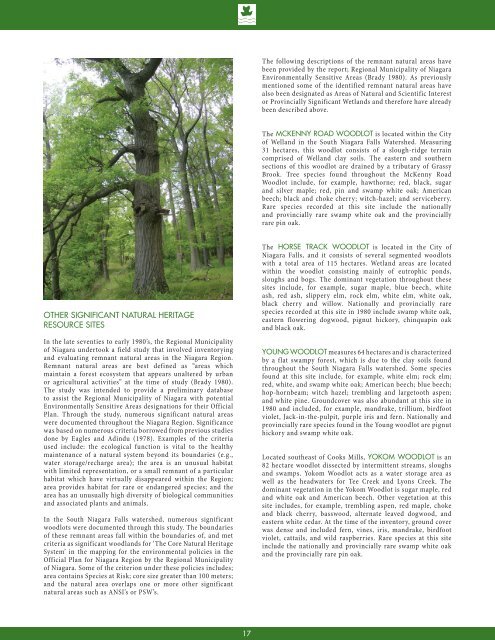8132 - NPCA SNF Watershed Report.indd - Niagara Peninsula ...
8132 - NPCA SNF Watershed Report.indd - Niagara Peninsula ...
8132 - NPCA SNF Watershed Report.indd - Niagara Peninsula ...
You also want an ePaper? Increase the reach of your titles
YUMPU automatically turns print PDFs into web optimized ePapers that Google loves.
The following descriptions of the remnant natural areas havebeen provided by the report; Regional Municipality of <strong>Niagara</strong>Environmentally Sensitive Areas (Brady 1980). As previouslymentioned some of the identified remnant natural areas havealso been designated as Areas of Natural and Scientific Interestor Provincially Significant Wetlands and therefore have alreadybeen described above.The McKenny Road Woodlot is located within the Cityof Welland in the South <strong>Niagara</strong> Falls <strong>Watershed</strong>. Measuring31 hectares, this woodlot consists of a slough-ridge terraincomprised of Welland clay soils. The eastern and southernsections of this woodlot are drained by a tributary of GrassyBrook. Tree species found throughout the McKenny RoadWoodlot include, for example, hawthorne; red, black, sugarand silver maple; red, pin and swamp white oak; Americanbeech; black and choke cherry; witch-hazel; and serviceberry.Rare species recorded at this site include the nationallyand provincially rare swamp white oak and the provinciallyrare pin oak.Other Significant Natural HeritageResource SitesIn the late seventies to early 1980’s, the Regional Municipalityof <strong>Niagara</strong> undertook a field study that involved inventoryingand evaluating remnant natural areas in the <strong>Niagara</strong> Region.Remnant natural areas are best defined as “areas whichmaintain a forest ecosystem that appears unaltered by urbanor agricultural activities” at the time of study (Brady 1980).The study was intended to provide a preliminary databaseto assist the Regional Municipality of <strong>Niagara</strong> with potentialEnvironmentally Sensitive Areas designations for their OfficialPlan. Through the study, numerous significant natural areaswere documented throughout the <strong>Niagara</strong> Region. Significancewas based on numerous criteria borrowed from previous studiesdone by Eagles and Adindu (1978). Examples of the criteriaused include: the ecological function is vital to the healthymaintenance of a natural system beyond its boundaries (e.g.,water storage/recharge area); the area is an unusual habitatwith limited representation, or a small remnant of a particularhabitat which have virtually disappeared within the Region;area provides habitat for rare or endangered species; and thearea has an unusually high diversity of biological communitiesand associated plants and animals.In the South <strong>Niagara</strong> Falls watershed, numerous significantwoodlots were documented through this study. The boundariesof these remnant areas fall within the boundaries of, and metcriteria as significant woodlands for ‘The Core Natural HeritageSystem’ in the mapping for the environmental policies in theOfficial Plan for <strong>Niagara</strong> Region by the Regional Municipalityof <strong>Niagara</strong>. Some of the criterion under these policies includes;area contains Species at Risk; core size greater than 100 meters;and the natural area overlaps one or more other significantnatural areas such as ANSI’s or PSW’s.The Horse Track Woodlot is located in the City of<strong>Niagara</strong> Falls, and it consists of several segmented woodlotswith a total area of 115 hectares. Wetland areas are locatedwithin the woodlot consisting mainly of eutrophic ponds,sloughs and bogs. The dominant vegetation throughout thesesites include, for example, sugar maple, blue beech, whiteash, red ash, slippery elm, rock elm, white elm, white oak,black cherry and willow. Nationally and provincially rarespecies recorded at this site in 1980 include swamp white oak,eastern flowering dogwood, pignut hickory, chinquapin oakand black oak.Young Woodlot measures 64 hectares and is characterizedby a flat swampy forest, which is due to the clay soils foundthroughout the South <strong>Niagara</strong> Falls watershed. Some speciesfound at this site include, for example, white elm; rock elm;red, white, and swamp white oak; American beech; blue beech;hop-hornbeam; witch hazel; trembling and largetooth aspen;and white pine. Groundcover was also abundant at this site in1980 and included, for example, mandrake, trillium, birdfootviolet, Jack-in-the-pulpit, purple iris and fern. Nationally andprovincially rare species found in the Young woodlot are pignuthickory and swamp white oak.Located southeast of Cooks Mills, Yokom Woodlot is an82 hectare woodlot dissected by intermittent streams, sloughsand swamps. Yokom Woodlot acts as a water storage area aswell as the headwaters for Tee Creek and Lyons Creek. Thedominant vegetation in the Yokom Woodlot is sugar maple, redand white oak and American beech. Other vegetation at thissite includes, for example, trembling aspen, red maple, chokeand black cherry, basswood, alternate leaved dogwood, andeastern white cedar. At the time of the inventory, ground coverwas dense and included fern, vines, iris, mandrake, birdfootviolet, cattails, and wild raspberries. Rare species at this siteinclude the nationally and provincially rare swamp white oakand the provincially rare pin oak.17
















